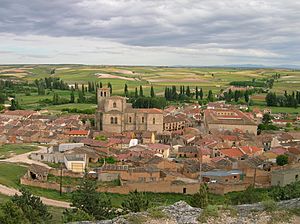Conjunto histórico facts for kids
In Spain, a special way to protect old and important places is called a Conjunto histórico. This name means "Historic Grouping." It's used to keep entire old villages safe, like Peñaranda de Duero, or the historic parts of bigger towns, such as Avilés. Think of it like protecting a whole neighborhood because it's special, not just one building.

The idea of a Conjunto histórico is similar to a "Conservation Area" in the United Kingdom. It focuses on a group of buildings or an area, not just a single monument. This protection helps make sure these places stay beautiful and important for future generations.
What is a Bien de Interés Cultural?
The Conjunto histórico is part of an even bigger system in Spain called Bien de Interés Cultural. This translates to "Asset of Cultural Interest." It's the main way Spain protects its cultural heritage, and the country's Ministry of Culture manages it.
Besides Conjuntos históricos, the Bien de Interés Cultural category also protects other types of non-moving heritage. These include:
- Jardín histórico: This means a historic garden, like the beautiful gardens of Aranjuez.
- Monumento: This is a single important building or structure.
- Sitio histórico: This refers to a historic site, such as the Bulls of Guisando, which are ancient stone sculptures.
- Zona arqueológica: This is an archaeological zone, like the amazing Archaeological Site of Atapuerca, where scientists find very old human remains and tools.
Sometimes, a Conjunto histórico can even include buildings that are already protected as individual monuments. For example, in places like Peñaranda de Duero or Covarrubias, you might find both a protected historic area and specific buildings within it that have their own special protection.
Examples of Conjuntos Históricos
Many places across Spain have been declared a Conjunto histórico. Here are a few examples and the year they received this special protection:
- Nogal de las Huertas (1931)
- Avilés (1955)
- Covarrubias (1965)
- Sos del Rey Católico (1968)
- Daroca (1968)
- Sanlúcar de Barrameda (1973)
- Peñaranda de Duero (1974)
- Santa Cruz de La Palma (1975)
- La Orotava (1976)
- Garachico (1994)
- Gumiel de Izán (2003)
- Frías (2005)
See also
 In Spanish: Conjunto Histórico para niños
In Spanish: Conjunto Histórico para niños

